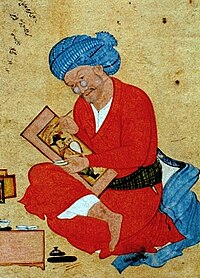Riza Abbasi
| Reza Abbasi رضا عباسی |
|
|---|---|

Posthumous portrait of Reza by his follower Mu'in, 1673
|
|
| Born | 1565 Kashan or Mashhad, Safavid Persia |
| Died | 1635 Tabriz, Safavid Persia |
| Occupation | Artist |
Reza Abbasi, Riza yi-Abbasi or Reza-e Abbasi, رضا عباسی in Persian, usually Reza Abbasi also Aqa Reza (see below) or Āqā Riżā Kāshānī (c. 1565 – 1635) was the leading Persian miniaturist of the Isfahan School during the later Safavid period, spending most of his career working for Shah Abbas I. He is considered to be the last great master of the Persian miniature, best known for his single miniatures for muraqqa or albums, especially single figures of beautiful youths.
Riza was possibly born in Kashan, as Āqā Riżā Kāshānī is one of the versions of his name; it has also been suggested that he was born in Mashad, where his father, the miniature artist Ali Asghar, is recorded as having worked in the atelier of the governor, Prince Ibrahim Mirza. After Ibrahim's murder, Ali Asghar joined Shah Ismail II's workshop in the capital Qasvin. Riza probably received his training from his father and joined the workshop of Shah Abbas I at a young age. By this date, the number of royal commissions for illustrated books had diminished, and had been replaced by album miniatures in terms of employment given to the artists of the royal workshop.
Unlike most earlier Persian artists, he typically signed his work, often giving dates and other details as well, though there are many pieces with signatures that scholars now reject. He may have worked on the ambitious, but incomplete Shahnameh, now in the Chester Beatty Library in Dublin. A much later copy of the work, from 1628, at the end of Abbas' reign and rendered in a very different style, may also be his. It is now in the British Library (MS Additional 27258). His first dated drawing is from 1601, in the Topkapi Palace. A book miniature of 1601-2 in the National Library of Russia has been attributed to him; the only other miniature in the book is probably by his father. He is generally attributed with the 19 miniatures in a Khusraw and Shirin of 1631-32, although their quality has been criticised.
...
Wikipedia
